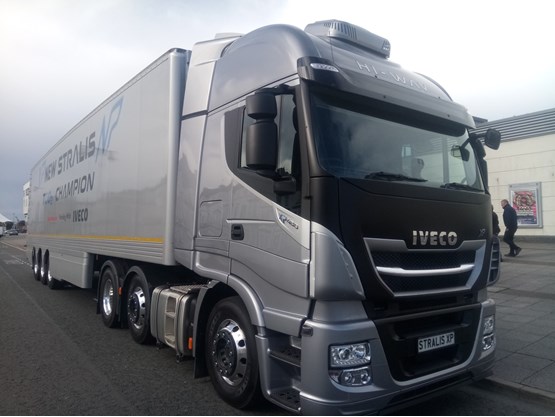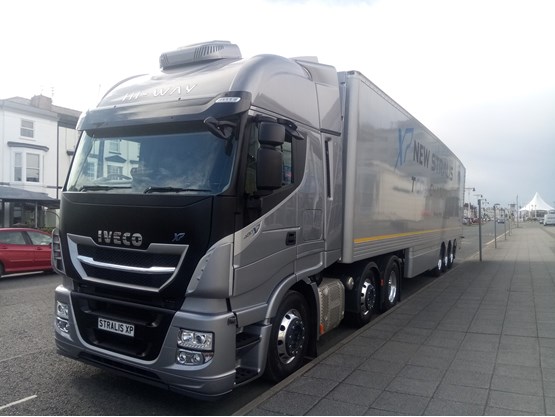Review
The ‘TCO2 Champion’ Stralis dispels the myth that Iveco only serves the lighter end of the UK truck market, Tim Campbell's review reveals.
Iveco has been producing trucks for the UK market for more than 30 years.
In fact, it even manufactured rigid trucks for many years at the old Ford Cargo site in Langley just outside Slough.
In some ways that possibly explains its long-standing affinity with the lighter end of the UK truck market and its consequent lack of penetration into the tractor/trailer sector.

That doesn’t mean the products aren’t suitable for the market.
No, it’s more of a result of the general perception that Iveco operates in the lighter end and doesn’t build products that keep up with the big players in the heavyweight sector such as DAF or Volvo.
So, with this mind, we decided to take a look at Iveco’s current offering to the UK tractor market to see if this assumption is true.
The Stralis is the successor to the EuroTech/EuroStar range Iveco produced in the ’90s and early noughties and was definitely a step up specifically in the cab environment area.
This was further enhanced when the second generation Stralis broke cover a few years back and this, incorporating a recent fine-tuned upgrade, is the Stralis we see on the market today.

The upgrade took place around 18 months ago with the introduction of the Stralis XP (eXtra Performance) and this has undergone a complete driveline redesign, from engine to tyres and features a new electrical and electronic architecture, transmission, new rear axle and suspension, and introduces the latest-generation GPS predictive functions.
We felt the obvious truck to test was the new and latest offering Stralis XP.
The XP is billed as the long haulage ‘TCO2 (total carbon dioxide) Champion’, designed to drive longer distances using less fuel. As such, one of the major product improvements has been around the engine and transmission.
According to Iveco, the total fuel savings could reach up to 11% for product and up to 3% for services and when all factors are considered (fuel, maintenance, value and uptime), this potentially reduces the total cost of ownership (TCO) of a long-haul mission by 5.6%.

Of course, key to this saving are the engines which feature the Iveco designed and built Cursor 9 and Cursor 11 series. For our test we had the latter engine rated at 487PS (there is a 578PS) with 2300 Nm of torque.
Interestingly Iveco has been the main protagonist of SCR (selective catalytic reduction) after-treatment to combat the requirements for Euro VI.
In the case of the XP, the Cursor engine features what Iveco calls ‘Smart EGR’ which works in combination with Iveco’s HiSCR and uses just 8% of exhaust re-circulation.
This allows an earlier start of injection, resulting in better fuel economy while maintaining the high 97% tailpipe NOx conversion delivered by the HiSCR system.
Of course, automated gearboxes are another of the essential keys helping any manufacturer achieve better fuel economy, ensuring the electronics ‘talk’ with the other major and minor components via sensors to achieve their fuel economy goal.

In the case of the XP they include Smart Auxiliaries that automatically disconnect or go into energy-saving mode when they are not needed and Iveco’s predictive GPS-based Hi-Cruise system controls driving assistance functions such as eco-roll, gearshifting and cruise control.
As for gearboxes, the XP features ZF’s new 12-speed automated transmission called the Hi-Tronix and features an EcoSwitch speed and torque limiter.
The Hi-Tronix reduces shifting time by 10% and is designed for almost twice the gearshifts of the previous generation improving durability by up to 1.6 million kilometres, and reduces sound ‘emissions’ by six decibels.
The 6x2 features a 4.1m wheel and an all-new 2.47 ratio rear axle with single reduction.

The whole rear suspension has been completely redesigned to make it more mass-efficient and durable, resulting in a lighter suspension while maintaining performance; translating into 45kgs more payload.
Front suspension is provided by steel springs for the 7,500kgs plated weight whereas rear suspension is provided by six pneumatic bellows for the rear two axles which have a rated plated weight at 4,600kgs and 11,500kgs.
As well as the plethora of electronic active and passive safety braking systems such as ABS, BAS, EBD and, of course, the engine braking, traditional braking is provided by 432mm ventilated disc brakes all round.
Tyres on front and rear axles are 295/80R22.5. The third central axle is a smaller 245/70R17.5 and these aren’t just standard tyres but new triple A eco-tyres developed by Michelin to minimise rolling resistance helping to achieve fuel savings of up to 1.5%.

From the outside, the XP model is obvious from other Stralis’s with a very bold Blue XP decal. Our test vehicle featured a great combination of grey all round with black at the front centre including the radiator grill.
The cab interior has been completely redesigned with a new dashboard and steering wheel with integrated phone controls, to the Iveconnect system with CD player, radio hi-fi and touch-screen display which also runs the Driving Style Evaluation function, the navigation system and advanced telematics services.
Of course there’s the normal cab availability of standard sleeper and twin sleeper with high roof and the sleeping area features a multi-section bed that folds in the centre to become a useful table.
In the high roof version, the upper bunk opens easily thanks to the tilting mechanism with air springs.

This ensures it can be quickly and easily closed, folding into the rear wall to maximise available space in the cab and it also has increased sound insulation.
Four steps to the cab floor help the driver reach the full-height leather seat, which is air suspended and offers good support to the necessary areas.
In front of the driver is a comprehensive instrument panel featuring a mixture of two large and small dials for speedo, tacho, fuel and water temperature, and a central LCD screen for all the ‘dynamic data’ such as Ecoroll status and current gear.
To the left on this semi-wrap-around dash is the automated gear selection via three silver buttons and at the side is another LCD screen featuring the infotainment system for items such as the sat-nav, radio and Bluetooth mobile phone.
Underneath the screen is the short handbrake lever and the heating and ventilation system controlled via a couple of rotary dials.

Starting the engine, producing virtually no audible increase in noise, and leaning forward to press the ‘D’ silver button on the dashboard together with releasing the short handbrake lever has us on the move in no time.
We took the test truck on a mixture of A roads, dual carriageways and motorways, representing a good selection of typical environments the truck would find itself in.
Inside the cab the overall colour is a light grey helping to create a ‘bright’ feeling and visibility is helped by a good size windscreen and large side windows.
As always in modern cabs, driving is a case of braking with the engine braking system adjusted via the right-hand steering wheel stalk and then setting the adaptive cruise control to maintain the speed post-braking, helping with a simple driving style.
The suspension is probably the only area where a slightly better set up could be achieved preventing the cab from ‘leaning’ when cornering, which was not on all occasions but was definitely there in the more pronounced corners.
Iveco has come on leaps and bounds in its tractor unit offering over the years, and the Stralis XP continues the march to more market acceptability, with the combination of reduced total life costs and improved driver and cab environment.
Assuming customers will try it, improved sales should follow.



















